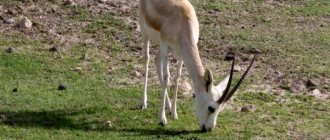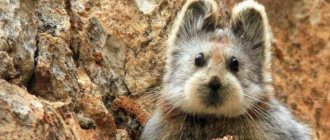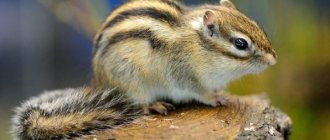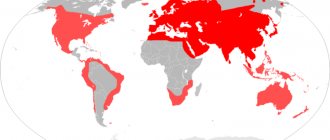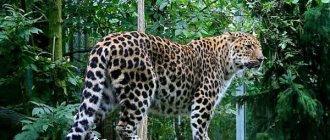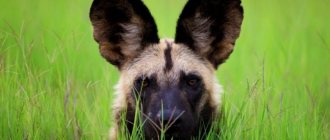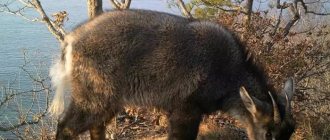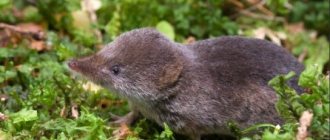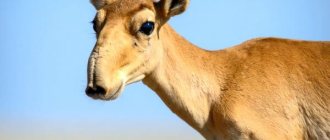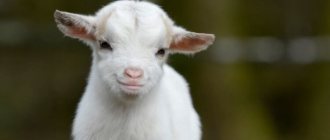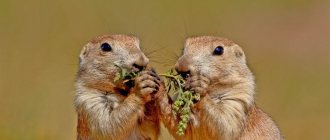The mongoose is a small predatory mammal from the suborder Felidae. The mongoose family includes 35 species. The ancient ancestors of the animal appeared on the planet about 20 million years ago. Its closest relatives are civets. For a long time, mongooses and civets and civets belonged to the same family. DNA studies carried out at the end of the last century and a detailed study of animal habits became the basis for identifying mongooses as a separate group.
Small predatory animals are very important for maintaining balance in ecosystems. The benefit of mongooses is to control the populations of insects, rodents and reptiles. According to the International Union for Conservation of Nature, the numbers of many members of the family are declining. Some of them are already included in the International Red Book with the status of “nearly vulnerable species.”
Characteristics and description of the animal
Banded
Mongooses are social animals: most species form small groups of one male, several females and their young. Sometimes the number of family colonies can reach 50 individuals. Animals are capable of caring for members of their group and jointly defending themselves against attacking enemies.
Animals often use burrows left by rodents as shelters. Depending on the region and living conditions, animals can arrange shelter in crevices or stone niches, in hollow tree trunks, and empty termite mounds.
Slim
Each group occupies a specific territory, the boundaries of which are marked by the sharply smelling secretion of the anal glands. Mongooses are diurnal. They usually hunt alone, occasionally uniting in groups to attack large prey.
Animals are characterized by sound communication. Using various sounds, they exchange information and report approaching danger. Mongooses have very well developed vision and sense of smell.
What does it look like
Indian Gray Mungo
The appearance of representatives of the mongoose family has the following features:
- the body is elongated with short fore and hind limbs;
- the paws have five toes with large non-retractable claws;
- the head is small, round, with an elongated muzzle and small round ears;
- the tail is long (equal to half the total body length), tapering towards the end.
Despite the fact that the animals live in warm regions, their fur is very thick. Dense fur provides protection against snake bites. The coloring of different subspecies is very different. The color is dominated by gray, brown, brown, red shades. The ends of the villi may be lighter. The feet are usually darker, sometimes black.
The mongoose's mouth contains between 32 and 40 teeth. The pupils are narrow, ovoid.
How many years do they live
Water
In their natural habitat, the lifespan of mongooses is 8-10 years. In captivity, the animal can live up to 14-15 years.
Dimensions
Javanese
Among mongooses there are both fairly large individuals and dwarf ones that grow to the size of ordinary rats. Below are average data for some members of the family.
| Species name | Body length, cm | Weight, kg |
| Water | 100 | 4,2 |
| Jackson's mongoose | 57 | 3,5 |
| Short-tailed | 45 | 3 |
| South African | 60 | 1 |
| Long-nosed Cusimanza | 37 | 1 |
| Yellow | 38 | 0,8 |
| Meerkat | 35 | 0,7 |
| Dwarf | 23 | 0,4 |
Types of mongoose
Short-tailed
Among the many varieties of the family, the following species are of greatest interest:
- Indian gray mungo ( Herpestes edwardsii ). Another name is used to designate the animal - the common mongoose. Distributed in India, Pakistan, Iran. It differs from other varieties in its silver-gray coat, which is darker on the paws.
- Long-nosed cusimanza . A small animal that lives in western Africa. A distinctive feature is the strongly elongated front part of the muzzle. Cuzimanzas tolerate captivity very well and are tamed. They are often kept as pets.
- Javan mongoose . The historical range extends to the south and southeast of Asia, the islands of Java, Sumatra and Borneo. Unlike its relatives, it leads a solitary lifestyle. In the last century it was introduced to South America and the Caribbean islands.
- Slender mongoose . It is found throughout Africa with the exception of desert regions. You can recognize the animal by its bright orange fur color. Slender mongooses are the object of hunting. Animals are hunted for meat and further use in medicine.
- Striped mongoose . It lives in the center and south of the African continent. Light gray and dark gray transverse stripes alternate on the body of the animal. Representatives of the species do not have permanent hunting territories and regularly move in search of food.
- Crabeater mongoose . One of the largest representatives of the family. Lives in southern China. The diet is based on crustaceans, crabs, frogs and other inhabitants of water bodies.
Natural enemies
Of course, mongooses are predators, but they are very small. Therefore, there are quite a lot of people who want to dine on small animals. Because of this, individuals leading a solitary lifestyle go hunting only at dusk, and daytime individuals collect food only under the supervision of a guard.
Natural enemies:
- leopards;
- large snakes;
- caracals;
- wild cats;
- hyenas;
- coyotes;
- jackals;
- lions;
- predator birds.
Not every predator can catch a fast and resourceful mongoose. Usually the prey is babies, sick or old animals.
Where do they live?
Mongooses are heat-loving animals, so their historical habitat extends to the African continent, the Arabian Peninsula, and the southern regions of Asia.
Where live
Natural areas suitable for mongoose habitat include tropical forests, savannas, arid steppes and semi-deserts. You can meet the animal on the plains and in mountainous regions covered with vegetation. The natural habitat of water mongooses is areas near rivers, lakes and swamps.
The animals are not at all afraid of people and are found in densely populated areas, setting up shelters near houses.
MARTEN
Spreading
The original habitat is in Asia. It extends from Pakistan, Afghanistan and the northern states of India to southern China and the Malay Peninsula and islands of Indonesia. The animals are common in Java, Borneo and Sumatra. They also live in Bangladesh, Bhutan, Cambodia, Laos, Myanmar, Nepal and Thailand.
At the end of the 19th century, Javan mongooses were introduced to the Caribbean islands, Japan, Vietnam, Central and South America. They are now also found in Hawaii, Fiji and the islands in the Adriatic Sea off the coast of the Balkan Peninsula.
Under natural conditions, these predatory mammals inhabit various types of tropical and subtropical forests, avoiding too dense forest areas. They often settle in open forests and open spaces; in the mountains they are observed at altitudes up to 2100 m above sea level.
There are 12 subspecies. The nominate subspecies lives in Java.
What do mongooses eat in the wild?
The animal's diet depends on the species. Among mongooses there are both carnivorous and omnivorous species.
Mongooses typically eat insects, small rodents, lizards and birds. The animals look for turtle and crocodile nests buried in the sand and eat the eggs there, breaking the shells with their hind paws. Berries and succulent rhizomes of plants are also eaten.
crabeater
Predators living near bodies of water hunt fry, crabs, crustaceans and frogs.
In the absence of other available food, mongooses may eat carrion.
Nutrition
All mongooses are divided into groups (20-25 individuals each). Usually they build themselves one common dwelling, which can have several entrances.
Members of the same group recognize each other by a special smell. Vocal contact is carried out between them through whistling, shouting and other sounds.
The animal's diet includes:
- fruits and berries (they can eat both animal and plant foods, collecting);
- insects, as well as their larvae (animals find them by examining grass hummocks and piles of fallen leaves);
- small reptiles and amphibians (there is even a special type of mongoose that feeds on crabs);
- chicks and bird eggs (the animal got used to breaking their shells on nearby stones);
- large reptiles (sometimes these are snakes, which mongooses hunt in flocks and less often alone, which can be seen in the photo below).
While some members of the group are feeding, a couple of others are sure to monitor their surroundings. When an enemy appears, they inform the others about it.
Mongooses' enemies are jackals, snakes and birds of prey.
Having heard a signal notifying of an impending threat, the animals instantly disappear into shelters: between the roots of trees, in rock crevices or minks dug specially for such an occasion.
Interesting! Mongooses brought to America by humans were not agile enough to cope with the rattlesnakes that plagued local farmers. In terms of reaction, reptiles acted faster than small predators.
Mongooses try not to attack king cobras, however, if a fight does take place, they will fight to the last
Reproduction and offspring
Long-nosed Cusimanza
Mongooses reach sexual maturity at the age of 12-14 months. Animals do not have a clearly defined mating season. Mating can take place with several partners from its family colony.
Gestation periods vary between species from 100 to 40 days. Most mongooses bear offspring for 2 months. Before giving birth, the female prepares a secluded place and lines it with dry grass and leaves.
Usually there are from 2 to 4 cubs in one litter. They are born blind and deaf and feed exclusively on their mother's milk for a month. At 2 weeks of age, babies' eyes and ear canals open and they begin to move independently. At one month old, the grown cubs begin to leave the shelter and become accustomed to solid food.
The social behavior of mongooses is manifested in general care for the offspring. All females of the colony can feed the growing babies with milk, and by the age of 3 months, each young mongoose has a guardian who teaches him to hunt. When danger arises, the entire group protects the young.
BADGER
Lifestyle
The South African mongoose is active during the day and leads a solitary lifestyle. Both sexes mark stones and bushes. These are carnivores that navigate in search of food using their eyes and sense of smell. Their prey is small rodents, primarily African swamp hamsters ( Otomys
) and striped field mice (
Rhabdomys
). In addition, insects also become their prey.
When threatened, mongooses emit a short, high-pitched growl and a sneeze or purr when grabbed. Breeding time is from August to December. There are from one to three cubs in a litter. The brood is born under bushes or in the burrows of other animals. The gestation period of the animals is unknown, as is their age at sexual maturity and life expectancy.
Why mongooses are not afraid of snakes
The small, agile animal is one of the few predators that can resist venomous snakes. In fights with cobras and vipers, mongooses win in 75-80% of cases. Successful snake hunting is possible for two reasons:
- The animals have a certain immunity to poison, so they do not die at the first bite of a snake. Reduced susceptibility to toxic substances is associated with the special structure of the mongoose’s nervous system and muscles: snake venom is not capable of causing paralysis. If the predator's attack is unsuccessful, repeated bites can be fatal.
- The mongoose's instant reaction allows it to successfully evade snake attacks and make swift attacks. During a fight, the animals jump up and bite the enemy in a vulnerable spot below the head. The speed and accuracy of mongoose attacks is their main advantage in a duel.
Content
In India, the animal has long been domesticated. Some entrepreneurs in this country create special nurseries where mongooses are bred.
Their grown cubs are sold there. If you want to take a small predator into your home, you need to know some points about its content.
- A mongoose needs a spacious cage. The animal cannot sit for a long time in a cramped and confined space. He gets bored there.
- Inside the cage you need to create the appropriate environment: place a couple of driftwood, put a ball or some other toy, put a tray for the mongoose’s needs.
- The animal is unpretentious in food. He can be given meat, fish, raw eggs, cottage cheese, vegetables and fruits. It is better to make the diet varied, combining animal and plant foods.
- To observe what a mongoose looks like during a hunt, sometimes you can bring a mouse, cockroach or frog into its cage. In this case, you should not experiment with snakes.
Interesting! Mongooses became famous among people after the release of R. Kipling’s story “Rikki-Tikki-Tavi”, where the main character, a mongoose, subsequently saved a child and his entire family from cobras.
The mongoose is easily tamed, responding with affection to the care and love of its owner.
You should not keep a mongoose with pets such as degu and lemmings - he will perceive them as a delicacy for lunch.
Meaning in nature and human life
In their natural habitats, mongooses regulate the numbers of reptiles, reptiles and rodents, many of which are pests or pose a danger to humans. In this regard, in the last two centuries, several attempts have been made to introduce mongooses to the American continent, Europe, Japan and other islands of the Pacific and Atlantic oceans in order to destroy the poisonous snakes living there, but all of them were unsuccessful.
The predators successfully took root in the new conditions, but this did not give the expected effect: contrary to popular belief, reptiles are not the animal’s main food and there is no particular reason for it to purposefully hunt snakes. In addition, in their natural habitat, mongooses are found only with rather slow cobras and vipers, so they were powerless against the lightning-fast rattlesnakes (in America) or jararak (on the Caribbean islands). At the same time, the emergence of a new species of predator in the ecosystem has led to a significant decrease in the populations of some rodents and small birds. Species such as the Antillean hamster, Jamaican rice rat, ameiwa lizard, and slittooth were completely destroyed.
Information obtained as a result of assessing the numbers of some native species after the introduction of mongooses served as the reason for adding the animals to the list of dangerous invasive species with a further ban on import.
OTTER
Area
Mongooses live over a vast territory stretching from West Africa to Southeast Asia. In addition, they were acclimatized in the West Indies, the Hawaiian Islands and Fiji.
By the way, mongooses, brought to Fiji to fight rats at the end of the 19th century, now pose the main danger to the local wildlife. Then it was not taken into account that rats are active at night, and our heroes are active during the day. Therefore, instead of destroying rodents, they greatly reduced the number of birds and iguanas.
Mongooses have managed to adapt to a wide variety of habitats and inhabit both dense forests and woodlands, as well as savannas and deserts. Some species dig branched systems of underground tunnels, others occupy holes abandoned by previous owners, and others lead a nomadic lifestyle.
For mongooses, the presence of suitable shelters in their habitats is of great importance. Thus, some species inhabiting the grassy plains of Africa, where the only available shelter is often only termite mounds, the animals prefer to settle in the ventilation shafts of large buildings of Macroternes termites. In places where there is plenty of shelter (in forests, rocky areas), they are often the most common and numerous predators.
Interesting facts about mongooses
- The modern name of the predatory animal comes from the English language. The English word “mongoose”, in turn, is a slightly modified borrowing from the Hindi (Mungus), Marathi (Munguza) and Telugu (Mungisa) languages.
- Among the ancient Egyptians, mongooses were sacred animals. The animal earned such respect by destroying crocodile nests, eating unattended eggs. One of the species found in Africa is called the Egyptian mongoose or Pharaoh's rat.
- Some species of mongoose are easily tamed and can even learn to perform a few simple commands. In natural habitats they are sometimes kept as pets.
- In dwarf mongooses, the leader of the colony is the female. Only she and the eldest male of the group can reproduce.
- Some civets, for example, the ring-tailed mungo, have a significant resemblance to mongooses, not only in appearance, but also in their behavior.
- Only the mongoose that defeated it can eat a killed snake. The rest of the family does not try to take the prey.
